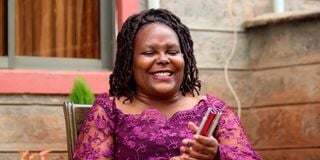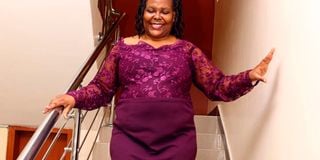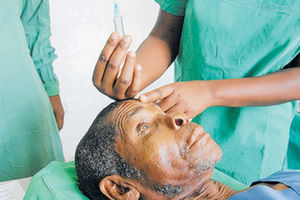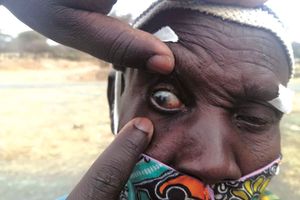‘I was once seeing, but now I’m blind: How rare disease stole my eyesight’

Pastor Angela Musyoka during the interview in AthiRiver, Machakos County.
What you need to know:
- Retinitis pigmentosa is a group of rare eye diseases that gradually impair vision by affecting the retina, the light-sensitive layer of tissue located at the back of the eye.
- It is a genetic condition that can be inherited from parents or grandparents, leading to the slow breakdown of retinal cells and eventual vision loss.
- Although there is currently no cure for RP, there are various management strategies available to help individuals with the condition.
“My name is Pastor Angela Musyoka. I am 49 years old.
As I sit here engulfed in darkness, my mind wanders back to a time when my world was filled with vibrant colours and the beauty of life. It feels like a lifetime ago when I stood before a classroom full of eager learners, teaching them the wonders of the world. Today, however, I share with you my journey with retinitis pigmentosa, a hereditary disease that robbed me of my eyesight.
It all began gradually, with a subtle fading of the world around me. At first I noticed words on the blackboard appeared blurry and indistinct. I could no longer read from the blackboard during my lessons at Athi Plains Academy, where I had the privilege of shaping young minds. Concerned, I sought medical help, desperate to understand what was happening to my vision.
I visited several doctors who made it seem like a non-issue and just recommended eye drops, but I was not improving.
A few months after visiting several hospitals, the final diagnosis was devastating. Two doctors, with furrowed brows, uttered a diagnosis that forever altered my life: Retinitis pigmentosa. They explained that it was a hereditary disease that manifested in the form of progressive vision loss. The more I aged, the more my sight diminished.
Hereditary disease? I wondered. Who in my family had lost their vision? No one came to mind. It was a bitter pill to swallow, accepting that I would never see again.
My journey into the abyss of blindness began in 2008 at the age of 33. Like a flickering candle, my sight dimmed with each passing day until I found myself completely enveloped in darkness by 2014. I would walk up the stairs and miss my steps. I would take my tea and not find my cup’s handle. People around me would wonder why I was moving my hands to feel things that were in front of me.
Life became an intricate dance of adapting to a new reality, one that required courage, resilience and an unwavering faith in the unseen.
The early days were the hardest. I longed for the familiar, for the simple joys of witnessing a sunrise or a child’s smile. It was a constant battle between despair and hope—between succumbing to the darkness or finding strength within myself to carry on.
As I was losing my sight, my marriage of 18 years was also coming to a slow but sure end.

Angela Musyoka turned blind at the age of 33.
The weight of these dual adversities took a toll on my emotional well-being. I also developed heart problems and sunk into depression, which took a severe toll on my mental wellbeing.
Frequent visits to the hospital became a stark reality.
When I went completely blind, I was supposed to go for rehabilitation at the Kenya Society for the Blind, but I did not have anyone to take me there.
The years that followed were suffocating. I withdrew from the outside world, locking myself away in my house. I could feel the weight of pity weighing me down, my self-worth eroding with each passing moment. The darkness that surrounded me became a cruel reflection of the despair that consumed my spirit.
Simple tasks that once brought me joy became insurmountable obstacles. I longed to escape from the prison of self-pity, but the fear of venturing into a world I couldn’t see was paralysing. The thought of stumbling and not being able to recognise the faces of loved ones or the colours of nature filled me with overwhelming anxiety.
Depression became my constant companion. I questioned my purpose, my identity and even my worthiness.
But amidst the darkness, a beacon of light emerged—my family. They stood by me, unwavering in their love and support. They refused to let me succumb to the depression and despair that threatened to consume me. Their comforting presence reminded me that I was not alone in this struggle.
It was through the unconditional love of my family that I found the strength to step out of my self-imposed prison. They patiently encouraged me, guiding me through the simplest of tasks and teaching me new ways to navigate the world without eyesight. Their unwavering belief in my ability to overcome this immense challenge gave me the courage to take the first steps towards reclaiming my life.
In 2017, a pivotal moment arrived. It was the year I finally accepted myself for who I truly was—a blind woman with an unyielding spirit and a burning desire to make a difference. I came to the realisation that no matter how hard I fought against my circumstances or how much pressure I put on myself, I could not change the reality of my blindness. And so I made a conscious decision to return to the essence of the Angela I once knew.
My recovery was not without obstacles. Physical health issues plagued me, leading to frequent hospital visits. However, counselling became an essential part of my healing process. Through therapy and self-reflection, I began to let go of the past and embrace a new chapter in my life.
Rebuilding my life required a firm commitment to acceptance. I realised that I could not change the circumstances that had befallen me, but I had the power to choose how I responded to them. I refused to be defined by my blindness; instead, I embraced my new reality and sought to create a meaningful life within it.
I have learned to rely on my other senses, cultivating a heightened awareness of the world around me. The sound of a bird’s song, the scent of blooming flowers, the touch of a loved one’s hand—these are the threads that weave a vibrant tapestry in my mind, painting a vivid picture of the beauty that still exists in the world.
It was during this time that I discovered the white cane, a symbol of empowerment and mobility for blind individuals. Holding the cane in my hand, I felt renewed determination to conquer the challenges before me. But mastering its use was not an overnight accomplishment; it required patience, practice and willingness to step out of my comfort zone.
The true test of my new-found skills came when I took my first steps outside, alone, with the white cane as my guide. Initially, I was filled with a mixture of excitement and trepidation. The outside world felt vast and intimidating, but the knowledge that the white cane would be my companion propelled me forward.
With each tap of the cane, I began to explore my surroundings in a new way. The tactile feedback provided by the cane allowed me to navigate confidently, identifying changes in terrain and obstacles in my path. It became an extension of myself, helping me to interpret the world through touch and sound.
As I ventured further, I discovered that the white cane not only served as a practical tool but also as a symbol of my independence. It became a powerful statement to the world that I could overcome adversity and thrive despite my visual impairment. It invited others to recognise my capabilities and treat me as an equal.
Through the white cane, I found liberation and a renewed sense of purpose. It opened doors to new opportunities and experiences. I could now explore my neighbourhood, visit local stores and engage in social activities with confidence.
Within no time, I started moving across the country preaching and soon I was on a flight traveling abroad to share the word of God.
One of the most significant steps in my journey was finding solace in faith. It became my anchor, providing me with hope and guiding me through the darkest moments. My unwavering belief in a higher power gave me the strength to face each day with renewed determination and unwavering resolve.
As I slowly regained my footing, I became a beacon of hope for others. I shared my story of resilience and transformation, inspiring those who found themselves in similar circumstances. Through my preaching and counselling, I encouraged others to embrace their own journeys of acceptance and to discover the strength that lies within.
My children, who were young when I lost my sight, did not initially grasp the gravity of my condition. But as they grew older, attending high school and university, the realisation hit them like a thunderbolt. They began to empathise with the challenges I faced, offering their unwavering support whenever they visited me (they live with their father). It warms my heart, yet I can’t help but sense the empathy they feel for me as they witness the limitations I confront daily.
Looking back, I am grateful for everything that has happened in my life even though I would have loved it to be different. Every twist and turn, every triumph and setback, has led me to this moment—the chapter of my life that is now filled with new experiences and profound meaning. It is a chapter adorned with the silver lining of faith, purpose and a calling greater than myself”.
Retinitis pigmentosa: Understanding the rare eye illness and its management
Retinitis pigmentosa (RP) is a group of rare eye diseases that gradually impair vision by affecting the retina, the light-sensitive layer of tissue located at the back of the eye. It is a genetic condition that can be inherited from parents or grandparents, leading to the slow breakdown of retinal cells and eventual vision loss. Although there is currently no cure for RP, there are various management strategies available to help individuals with the condition, explains Dr Dheeraj Kewlani, a consultant retina and cataract surgeon at Lions Sightfirst Eye Hospital.
“The progressive genetic disease typically manifests in childhood, with individuals eventually losing a significant portion of their sight,” explains Dr Kewlani. “While there is no cure, there are ways to optimise the remaining vision and improve the quality of life for those affected.”
Diagnosing RP is a straightforward process and can be done during a comprehensive dilated eye exam. During this painless procedure, doctors administer eye drops to dilate the pupils and carefully examine the eyes for signs of RP and other ocular issues. The examination also includes a visual field test to assess peripheral vision. Regular eye exams are crucial for individuals with RP as they allow eye doctors to monitor symptoms and recommend appropriate treatments.
Dr Kewlani emphasises the importance of early detection and intervention, stating, “regular eye exams enable us to identify and address associated eye problems such as refractive errors, cataracts or cystoid macular edema, which can significantly impact an individual’s vision. By detecting and treating these issues promptly, we can help patients maximime their remaining vision.”
The most common early symptom of RP is night vision loss, which typically begins in childhood. «Parents may notice that their children struggle to navigate in the dark or adjust to dim lighting. RP also affects peripheral vision, gradually narrowing the field of view until only central vision remains, akin to tunnel vision. Additional symptoms include sensitivity to bright light and loss of color vision.
“RP progression varies from person to person due to the involvement of different genes,” notes Dr Kewlani.
“On average, RP patients experience a decline of approximately 16–18.5 per cent per year in remaining ERG (electroretinogram ) amplitudes.”
While there is no definitive cure for RP, various management techniques can help individuals cope with the condition. Low-vision aids and assistive devices such as magnifiers and specialised technology can enhance visual capabilities. Additionally, wearing sunglasses and minimising exposure to bright lights can help alleviate symptoms.
Dr Kewlani mentions: “In some cases, treating associated conditions like cystoid macular edema or cataracts becomes necessary. Surgical procedures may be recommended to address these issues and improve overall visual function.”
The introduction of gene therapy has brought promising advancements in the fields of RP and inherited retinal diseases (IRDs). The US Food and Drug Administration has approved voretigene neparvovec-ryzl (Luxturna®), a gene therapy product specifically designed to treat a specific type of RP caused by mutations in both copies of the RP65 gene. Clinical trials are ongoing for gene therapy treatments targeting other forms of RP and IRDs.
For individuals with severe RP, an artificial retina, known as a retinal prosthesis, may be an option. This innovative technology can restore limited visual function by bypassing damaged retinal cells and stimulating the remaining healthy cells, explains the doctor.
When asked about prevention strategies, Dr Kewlani explains, “Since RP is primarily inherited, prevention is not possible. However, there are steps individuals can take to maintain optimal eye health and potentially slow the progression of RP.
Dr Kewlani advises the following:
“Regular appointments with an ophthalmologist are crucial to monitor the condition and make informed decisions about treatment options. Protecting the eyes from excessive light exposure by wearing sunglasses and avoiding bright lights can also be beneficial.”
“While RP presents unique challenges, with the right support and management, individuals with this condition can still lead meaningful and productive lives. It is crucial to stay informed, seek appropriate medical care and embrace the available resources and technologies that can make a significant difference in day-to-day visual function and overall well-being.”





